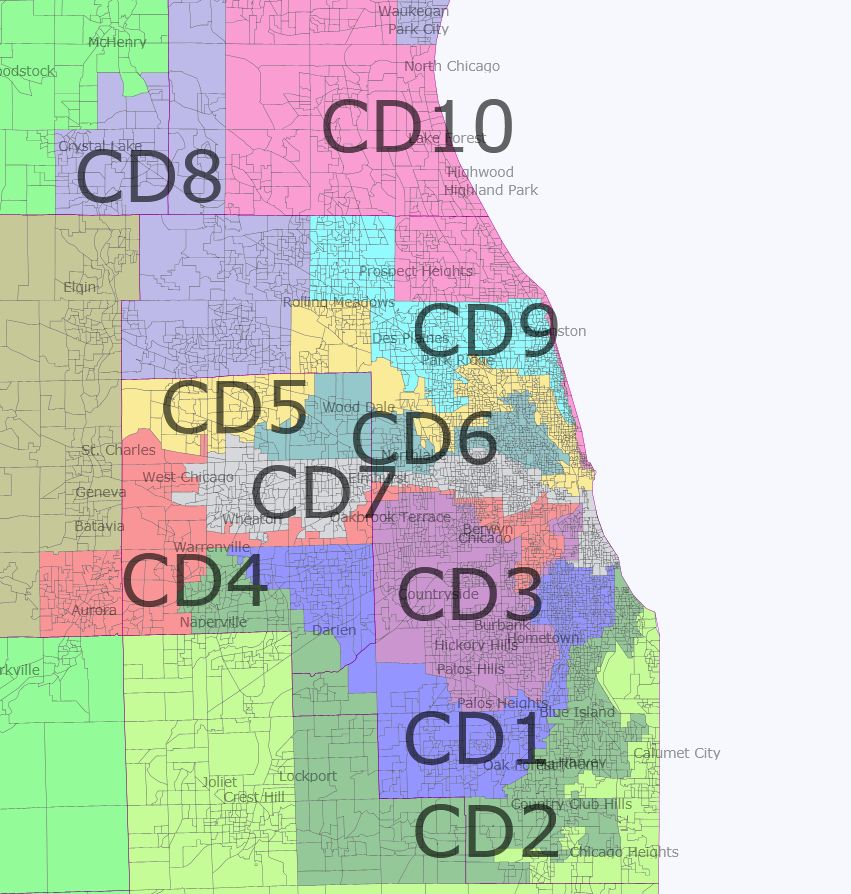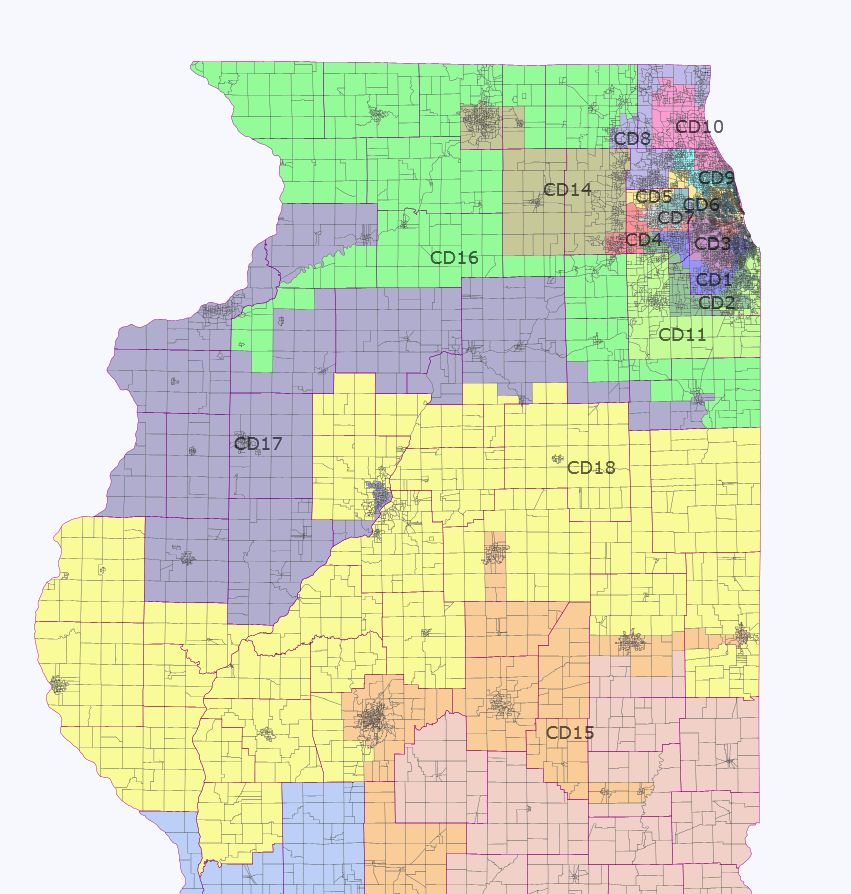The GOP again has control of the redistricting trifecta in Pennsylvania. Last time, it didn’t go as well as planned, as its intended 13 R & 6 D delegation (12 R + ousting Tim Holden) ended up a dummymander by 2008 (12 D & 7 R representatives).
This time around, the Republicans have the challenge of shoring up regained seats around the state, in addition to the probable elimination of one of the Democratic delegation. My goal here was to accomplish that, in addition to a couple of other curve balls:

All of the districts are within +/- 650 people, based on 2008 population estimates. And without further wait, let’s start!
Northwest PA:
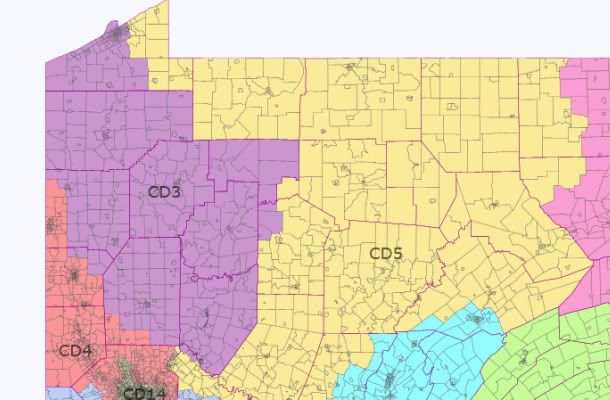
PA-3: Rep. Mike Kelly (R-Butler)
93% White, 4% Black, 3% Other
52% McCain, 47% Obama, (49% McCain, 49% Obama)
PA-3 shifts a few points to the right, as PA-5 takes eastern Erie county in exchange for more rural precincts. With the old PVI R+5.2 in addition to the rightward shift in the district, Kelly should be safe in most years.
PA-4 : OPEN; potentially Rep. Jason Altmire (D-McCandless)
93% White, 4% Black, 3% Other
53% McCain, 46% Obama, (no shift)
Surprisingly, it is fairly easy to remove Rep. Jason Altmire out of PA-4 by combining McCandless (his residency) with Mike Doyle in PA-14 in exchange for more Republican parts of Allegheny County. If he doesn’t decide to move within the district, this would probably be an GOP gain as the area is trending Republican with most of the state reps & senators being GOP members. On the other hand, if Altmire sees the primary with Doyle as unfeasible (likely) and doesn’t decide to retire, PA-4 could be the successor to the current PA-17 (Dem incumbent too personally popular to be unseated).
PA-5: Rep. Glenn Thompson (R-Howard)
96% White, 4% Other
54% McCain, 44% Obama, (55% McCain, 44% Obama)
Thompson’s district moves westward and southward, taking parts of Allegheny and Erie county in order to shore up other less safe districts. Nothing too exciting here.
Southwest PA:
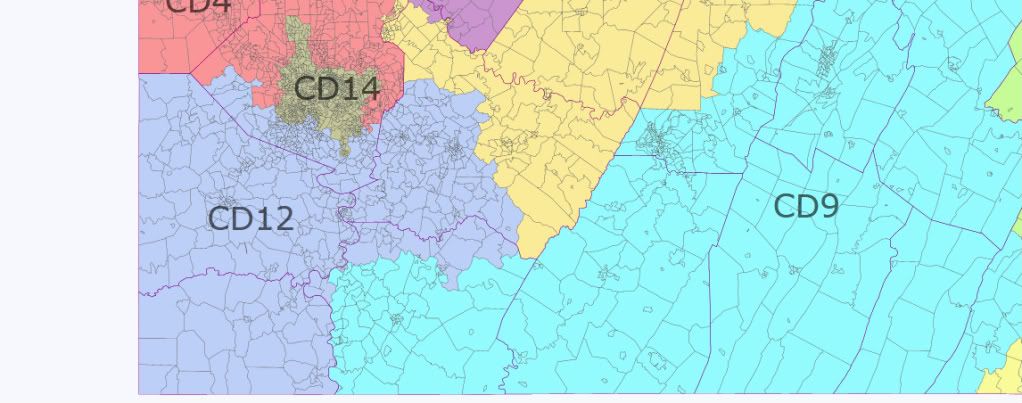
PA-9: Rep. Bill Shuster (R-Hollidaysburg) vs. Rep Mark Critz (D-Johnstown)
93% White, 3% Black, 3% Other
55% McCain, 43% Obama, (63% McCain, 36% Obama)
Sorry, Mark Critz, but you’re most likely going to be out of office come 2012. The new PA-9 takes part of the former Murthamander of PA-12, including Critz’ home base of Johnstown. At a 55% McCain district with a non-Tim Burns opponent, he’ll need the stars to align in order to beat Shuster. Other than that, PA-9 shifts westward.
PA-12: Rep. Tim Murphy (R-Upper St. Clair), formerly PA-18
95% White, 3% Black, 2% Other
55% McCain, 44% Obama
Murphy snatches most of the rest of PA-12 along with the former PA-18, as southwest PA is where population growth is the lowest. The McCain-Obama margin stays about the same as it was in the old PA-18.
PA-14: Rep. Mike Doyle (D-Forest Hills)
72% White, 21% Black, 3% Asian, 4% Other
67% Obama, 32% McCain ,(70% Obama, 29% McCain)
Mike Doyle’s district, still centered around Pittsburgh) becomes slightly less Democratic with the addition of Altmire’s base of McCandless. Doyle probably doesn’t have to worry about a primary from his right, so he should be in the clear.
Northeast PA:
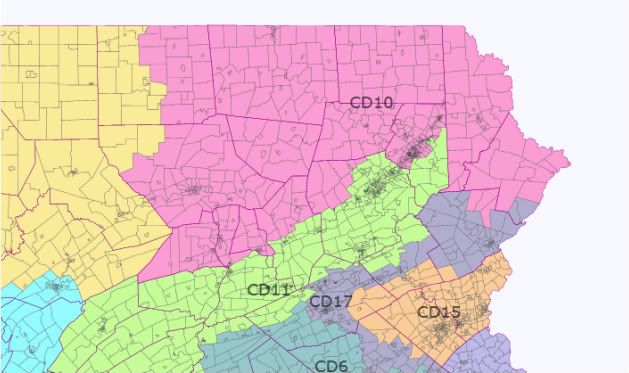
PA-10: Rep. Tom Marino (R-Lycoming)
93% White, 3% Black, 4% Other
51% McCain, 48% Obama, (54% McCain, 45% Obama)
It is really difficult to make all the Republicans in Eastern PA safe, as Tim Holden’s district can only hold so much population. Neither Lou Barletta nor Tom Marino are strong candidates, so I had to choose one of them to shore up more. As you can see, Marino took the hit (aka Scranton). Carney would probably be good for a comeback here in a good Dem year, as Marino probably won’t be the most ethical congressman. However, Lackawanna County isn’t trending Democratic at the federal level (Obama vs McCain margins were about the same as Gore vs Bush, a substantially more Republican year), so even if Marino were to lose, a better candidate could probably have at least an even chance of regaining the seat.
PA-11: Rep. Lou Barletta (R-Hazletown)
94% White, 3% Hispanic, 3% Other
53% McCain, 46% Obama, (57% Obama, 42% McCain)
Lou Barletta is the beneficiary of the Scranton switch, going from a 57% to 46% Obama district. His district drastically shifts southwest, taking in the majority of the old PA-17, minus Schuylkill county, and eastern parts of PA-9. He should be in pretty good condition here.
PA-15: Rep. Charlie Dent (R-Allentown)
81% White, 12% Hispanic, 4% Black, 3% Other
55% Obama, 43% McCain, (56% Obama, 43% McCain)
It is possible to make Charlie Dent theoretically safer by taking parts of Allentown or Bethlehem into PA-17 while grabbing more McCain-friendly precincts. However, it would probably backfire on the Republicans, as it would remain an Obama district (52 or 53%). Additionally, it would break up the Lehigh Valley, which historically has voted for a Republican for all but 6 years since the 1970s and has been in only one district for even longer. Cracking Allentown would probably harm Dent more than help, as the “communities of interest” would potentially be an issue. As a result, it only becomes slightly more Republican, taking in more conservative parts of the Valley.
PA-17: Rep. Tim Holden (D-St. Clair)
78% White, 12% Hispanic, 6% Black, 3% Asian, 1% Other
56% Obama, 43% McCain, (51% McCain, 49% Obama)
This district took quite a bit of effort and I’m not sure if it would hold up or not. Basically, it makes Tim Holden safe, along with shoring up other suburban GOP reps. With the most conservative part being his base, Holden takes in Reading, most of Monroe County, and chunks of Carbon & Montgomery Counties (PA-13 alone can’t shore up all of the southeastern Republican seats). Basically, it becomes a Democratic vote sink. There could possibly be a chance that Holden moves westward in Schuylkill and takes on Gerlach or Barletta if he fears a primary challenge in a more Dem-friendly district. However, their districts are more conservative than the previous PA-17 so he’d probably have a better shot in this district.
Southeast PA (Philly Suburbs):
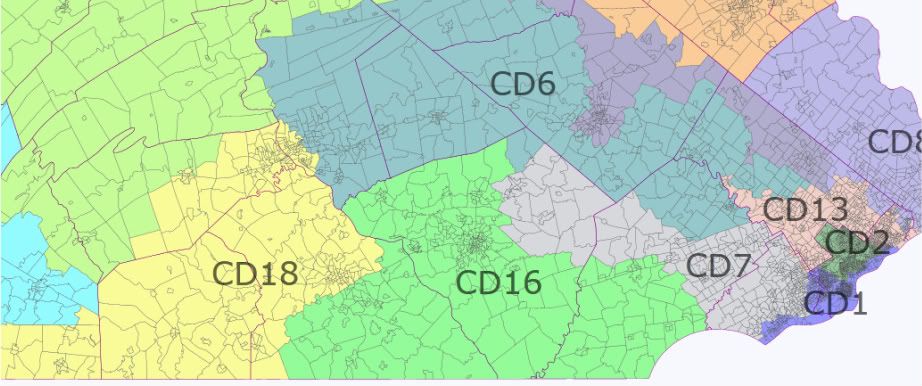
PA-6: Rep. Jim Gerlach (R-West Pikeland)
90% White, 4% Black, 3% Hispanic, 3% Other
52% McCain, 47% Obama, (58% Obama, 41% McCain)
From D+5 to R+6, how things change for Jim Gerlach. PA-6 becomes a lot more rural, stretching westward out from the suburbs in addition to giving Reading over to Tim Holden in exchange for much of the old PA-17. Gerlach has repeatedly shown a knack for survival, hanging on in great Dem years like 2006 & 2008, so he should be safe in this district. Even if he tries again for higher office, a moderate-conservative Republican should be able to hold on to the new PA-6 fairly easily.
PA-7: Rep. Pat Meehan (R-Drexel Hill)
89% White, 4% Black, 4% Asian, 3% Other
51% Obama, 48% McCain, (56% Obama, 43% McCain)
With Allyson Schwartz’s district becoming a more Democratic vote-sink, PA-7 reddens a good deal. Meehan’s new district picks up parts of Pitts’ and Gerlach’s old districts while dropping more Dem-heavy precincts to the Philly districts. Overall, this should help Meehan to entrench himself in the district more than before.
PA-8: Rep. Mike Fitzpatrick (R-Levittown)
88% White, 4% Black, 4% Asian, 3% Hispanic, 1% Other
53% Obama, 46% McCain, (54% Obama, 45% McCain)
There isn’t a whole lot that can be done for Mike Fitzpatrick either, other than shifting the margin to what Obama won by nationally. In 2006, a good Democratic year, Patrick Murphy only beat him by 1500-some votes, a margin that the switch of precincts with Allyson Schwartz would probably have eliminated. PA-8, basically, remains a swing district, but leaves Fitzpatrick in a slightly stronger position.
PA-16: Rep. Joe Pitts (R-Kennett Square)
85% White, 8% Hispanic, 5% Black, 2% Other
53% McCain, 46% Obama, (51% McCain, 48% Obama)
Joe Pitts’ Lancaster-based district moves somewhat westward out of the suburbs, thus becoming slightly safer for him. Still, if current trends hold, all of the Philadelphia suburban districts are going to end up places where the GOP will have to sweat, regardless of this round of redistricting. Pitts will probably need to tone down his anti-choice rhetoric or even moderate somewhat in order to keep the district in the mid-long term.
PA-18: Rep. Todd Platts (R-York)
82% White, 9% Black, 6% Hispanic, 3% Other
52% McCain, 47% Obama, (56% McCain, 43% Obama)
I had to put Harrisburg somewhere, and unfortunately for Todd Platts, it gets thrown into his district. Putting Harrisburg in any other district presents a higher risk to the GOP, as Joe Pitts and Jim Gerlach both have to worry about further Democratization of the Philly suburbs. The district is still fairly Republican, so Platts should be pretty safe.
Philadelphia:
PA-1: Rep. Robert Brady (D-Philadelphia)
46% Black, 41% White, 7% Asian, 4% Hispanic, 2% Other
83% Obama, 16% McCain, (88% Obama, 12% McCain)
Majority-minority district for Brady. It just stretches out more along the Delaware River than before, nothing too drastic.
PA-2: Rep. Chaka Fattah (D-Philadelphia)
53% Black, 23% White, 18% Hispanic, 4% Asian, 1% Other
91% Obama, 8% McCain, (90% Obama, 10% McCain)
It is possible: Chaka Fattah’s district can become even more Democratic, albeit slightly. It also becomes a lot more compact while remaining VRA at 53% black & only 23% white. It also sheds some precincts to PA-13.
PA-13: Rep. Allyson Schwartz (D-Jenkintown)
79% White, 9% Black, 6% Asian, 5% Hispanic, 1% Other
64% Obama, 36% McCain, (59% Obama, 41% McCain)
PA-13 gains a lot more Dem voters and in the process makes the rest of the Republican suburbs safer. It basically switches parts of Montgomery county with other districts in order to grab all of the 60%+ Obama precincts. Allyson Schwartz, winning by a 13% margin in 2010, is there for as long as she wants to be in Congress.
—–
Overall, I think the Republicans will go for a map somewhat like this. They might go with a Dem-vote sink in NW PA with Altmire by combining PA-4 with Erie, but I don’t think they’re going to cede to Altmire that easily. Another option would be for Holden to take Scranton and drop some of SE Pennsylvania, but a similar district failed to pass last round I believe. GOP wins in PA-10 & 11 this year complicated things for them, as the legislature is foremost going to try for R-incumbent protection.
So any thoughts? I’m not from PA (no Florida precinct information on Dave’s app yet 🙁 ), so I’d be curious to see if anyone from there would think this would hold up.





